Chime led me down a narrow grass pathway at Tashi Palkhiel, the Tibetan refugee settlement on the outskirts of Pokhara, Nepal where he’d grown up. Midway down the lane he stopped before a diminutive man with a long gray ponytail and gleaming onyx eyes. The elder Tibetan grasped my translator’s hands between his own as they bowed and touched foreheads in a respectful greeting. Pau Nyima Dhondup, the village shaman, or Lhapa, flashed a broad smile and considered me for a long moment, his eyes broadcasting delight and laughter, along with a healthy dose of mischief. Shepherding us to his modest home, the shaman swept aside a floor-length cloth covering the front door and gestured for me to sit on a daybed pushed up against the near wall of his front room.
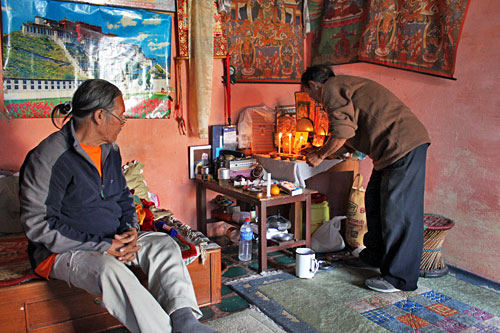
Pau Nyima, who practices a shamanic tradition passed down through his maternal bloodline, is one of only two known living Tibetan shamans remaining in the world today, according to the Foundation for Shamanic Studies in Mill Valley, California. He was chosen to continue his family’s healing tradition when he entered puberty and started having spiritual experiences that indicated his fate was to be a Lhapa. In addition to sucking illnesses out of a body, with actual objects being spit out to show the patient the source of their illness, shamanic treatments can also include a soul retrieval ceremony, a ceremony to release a deceased soul who is stuck into the afterlife, or a ritual to end misfortune that causes child after child in a family to die. The shaman drew up a chair in front of me and gave instructions to Chime.
“He wants you to support right elbow in palm of left hand and bend arm up in air.”
He felt the pulse at my wrist and motioned for me to switch arms in order to repeat the process on the other arm. Scooting back his chair to the middle of the room, he listened attentively as Chime described the pain in my left hip and knee and chortled when he demonstrated how I have to open my mouth wide to relieve the muscular tightness in my jaw, then asked questions.
“How old you are?” Chime inquired.
“Fifty-eight.”
“Ahhh!” the shaman exclaimed, as if learning my age had given him a major clue to my health.
“What country?”
“USA. But I don’t live there any more.”
Chime explained that I am a perpetual traveler with no permanent home, that I move from place to place around the world in search of travel stories. Satisfied that he had all the necessary information, Pau Nyima sat cross-legged on a second daybed on the other side of the small room. While donning a gold silk brocade apron and cape, he warned that we could take photos during part of the ceremony, but strongly recommended that we not use the camera once his body was taken over by the spirit because the deity often breaks things. He finished off his attire with an ornate green, blue and red headdress while his mediator, who runs the ceremony once the shaman is possessed, set up rice offerings, lit candles, and positioned photos of the shaman’s various deities on the altar.
“You must believe,” he warned gravely before beginning. His right hand held an hourglass-shaped, double-sided hand drum that represented two inverted skulls and symbolized the joining of female and male energies. Two clappers attached to strings hanging from the drum’s handle flew through the air as he rotated his wrist back and forth, striking the animal-hide drum in a four-beat rhythm, interspersed with chiming from a bell held in his left hand.
“You have two white stars in the east, a yellow one in the south, blue in the north and red in the west. You must pray only to Buddha – no other gods,” Chime translated for me. The shaman stopped briefly to add a second headdress that spread out behind him like rainbow angel wings and draped it with multi-colored silk scarves. Seconds later, while chanting intensely, a shudder passed through his body and a grimacing, contorted visage appeared superimposed on his face. He uttered a sharp yelp and threw a handful of silk scarves at me. Jumping off the daybed, he spread his arms wide and balanced on one foot, holding the other foot high in the air as if preparing to throw a karate kick. Nyenchen Thanglha, one of the strongest Tibetan deities, had taken control of his body.
Following a brief dance around the center of the room, Pau Nyima resumed his seat and motioned for me to sit directly in front of him on a low wicker stool. Almost immediately, he sprang forward from his sitting position and chomped the air above my upper left arm. The mediator poured a small amount of water into a tin dish and held it as the shaman spit out an inch-long slug that looked like a dark gray caterpillar; it squirmed around in the water, turned black and eventually stopped moving. Unexpectedly, the shaman lunged at me again, this time grazing my left left arm just above the elbow, and spit out a second, blacker slug. As I returned to my seat on the daybed, my arm turned ice cold and tingly.
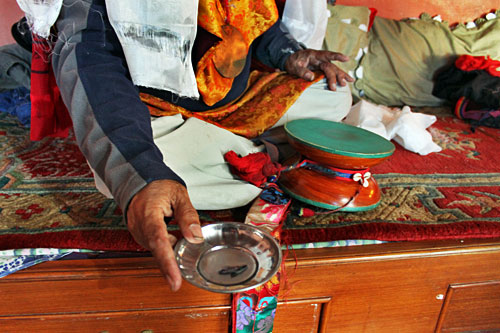
The deity departed as suddenly as it had arrived. Unaware of what had happened during the time his body was possessed, the shaman turned to his mediator for a briefing. Nyima held out the two unmoving slugs for photos, then raised the plate to his mouth and swallowed them with a gulp and shudder before delivering my diagnosis and instructions for recovery:
- I must believe
- I must pray only to Buddha
- I must not eat meat
- I am coming into my 59th year, which is not auspicious for a woman, thus I must have a lama chant a puja on my behalf
- I must take the Tibetan natural medicine Ratna Samphal (also known as Sambe) – once now and one in six months
- I must not go into cemeteries as I am susceptible to picking up negative energies, such as the ones he removed from my body
- I must regularly chant Om Mani Padme Hum
- I should not travel so much; it would be better to stay in one place much of the time and it would be positive for me to settle in Nepal
In the weeks that followed, I had little trouble following the shaman’s prescription. I am a Buddhist, I’m a vegetarian, I regularly chant Om Mani Padme Hum when I meditate, and staying longer in Nepal is hardly a hardship. But just to be safe, I asked Chime to arrange for a lama at the community’s Jangchub Choeling Monastery to chant a puja and later hunted down the recommended natural medicine.
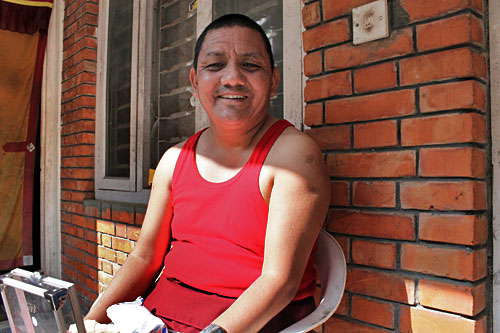
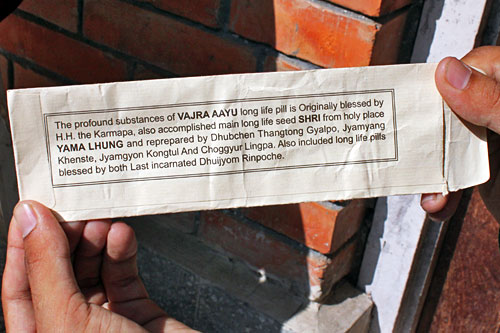
So do I believe? I know what I saw and my arm was ice cold the rest of the day, so yes, I definitely believe. And I am not alone. Recently, the Foundation for Shamanic Studies named Pau Nyima a “Living Treasure of Shamanism” and provided him with a lifetime annual stipend, assuring that he will be able to pass on shamanic knowledge that is rapidly disappearing from the face of the earth.
If you plan to visit Pokhara and would like to experience a shamanic healing with Pau Nyima Dhondup, take a taxi to Tashi Palkhiel Tibetan Refugee settlement. Since the young man who arranged my visit has now emigrated to Canada, the only way I know to find Shaman Pau Nyima is to show up at the camp and ask around for him. I have done this several times; he is often in the center of the camp socializing with other men. A taxi should cost you between 500-700 Rupees ($5.50 to $8 USD) round trip, which includes a one hour wait while you meet with the Shaman.
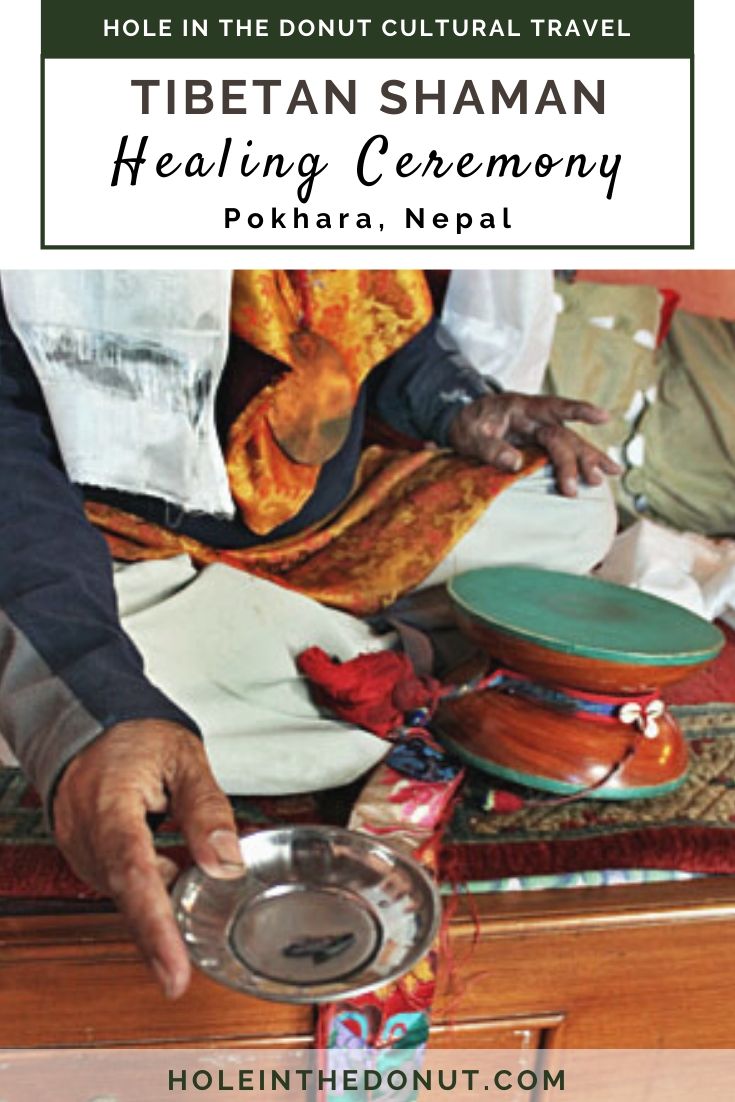

Hello Barbara! I am going to Nepal in June and I would very much like to visit this Shaman. How did you find a translator and how much was it? Do you think the Shaman is still around?
Lovely to hear about your experience!!
Hi Anton: I wish I could help but the translator I used has left Nepal and I don’t know how to reach the shaman anymore.
Hi BArbara,
Thank you for answering. Does this mean that the Shaman has moved> Or could I still turn up in the village and ask around for him> Thank you!
Hi Anton: You could try going to the Tashi Palkhiel Tibetan Refugee settlement and asking around for him.The settlement is just a short distance out of town and his name is Pau Nyima Dhondup. Sometimes he sits in the village square with the other men. The problem you will have is getting a translator, though Pau Nyima does speak a bit of English and maybe he an arrange for someone for you. He cannot translate himself during the ceremony because he goes into trance and his helper is busy doing other things. Hope that helps.
This video is so very helpful right now. I was planning a trip to Sri Lanka, because I do feel I have attached to me some negative entity. Perhaps, Barabara, do you think this shaman can do entity clearing? I’m considering a long stay, maybe up to two months, and if I find a teacher I might stay indefinitely. I’m a Theosophist, and like you I’m a vegetarian. But I want to join one of the two schools of Buddhism, I thought of the southern school, which is practiced in Sri Lanka, but again it’s so isolated, I mean the Island. I should be a happy man if I can find and a teacher who is willing to initiate me in some esoteric buddhist order.
Hi Samuel. I believe he could clear an entity, as that was part of what he did for me. Keep in mind that the Shaman, although by virtue of being Tibetan, is a Buddhist in the Mahayana tradition, however his work as a shaman harkens back to pre-Buddhist animistic beliefs. Nepal is also quite isolated, so I’m not sure it would be a better option, though I personally prefer Mahayana to Theravada. If you’re serious about Mahayana, I suggest NW India in McLeod-Ganj and Dharamsala, which is the seat of the Tibetan government in exile. It is a vibrant place with many opportunities to learn about Buddhism, including teachings by H.H. the Dalai Lama, who resides there.
Hi! I am more than glad to run into your post. I am a college student who receently ran into Bon tradition in Houston! AND I absolutely love it and was thinking about going to Tibet or Nepal to get more experiences about it, and also learn some Tibetan as well! So I was wondering if you think it would be possible or feasible for me to stay and study with the shaman for like a month or longer than a month (ideally for some period of time during my summer break this year). thank you so much for such a great testimony.
Hi Sgong90: I think it would be entirely possible. He is open to working with people on a long-term basis and I believe he speaks some English.
Not sure I believe the slugs but superbly told story of a wonderful expereince.
Seeing that your pills were probably blessed by H.H. the 16th Karmapa brings a smile to my face.
So glad that you got rid of those black slugs that were bothering you! I’m sure that whatever kind of doctor you attend there’s always the healing powers of care and attention and positive thoughts.
Great story. So your Tibetan Shaman has a Facebook page? Wonders never cease. What a trip!
What a powerful story! And of course – as always – superbly told. I always keep coming back for more!
Barbara,
Your narrative had me leaning forward in my chair. I’ve always been curious about eastern medicine, so this story was a definite treat for me. I’m glad that the process has helped you to feel better. Keep sharing your wonderful stories, I learn so much from them.
Thank you Renee! Glad you enjoyed it so much. It was definitely a thrill for
me to be able to experience the Shamanic healing ceremony.
I loved this story! I did my anthropological studies in college over Shamanism, and I really love to read successful stories of people outside the culture accepting Shamanism. Very inspiring article!
Wow, what a unique experience! Thanks for sharing, Barbara! How’s the jaw doing now btw?
Hi Brooke: The hip and knee seem completely healed but the jaw is still
giving me problems. Maybe I need to have a couple more slugs removed. 🙂
Glad you enjoyed the story.
Barbara,
Great story. Thanks for relating it to us with a nice video and photos. Just when I thought your Nepal experience couldn’t get any better, you share more. Bravo.
Jason
Thank you, Jason. And there’s stll more to come. 🙂
I think these days, more of us Western folk are finding it easier to open our minds to practices such as Shamanism. I’ve just read through the comments and it’s amazing that the pain in your hip and arm has gone. Are you able to go hiking now?
As for the slugs; I’m not sure if I would have been revolted or amazed when they came from his mouth!
Julia
Hi Julia: I’ve not yet tested the hip and knee with a long, strenuous hike,
but have done some milder ones with absolutely no problem. I am thrilled; I
was really worried that my hiking days were over, and it is something I
dearly love to do.
It must be absolutely surreal to go from the typical western system of get a prescription and drugs back to a culture like Tibet!
Hi Wandering Trader – surreal yes, especially since his medicine seemed to
work!
I heart this post!!! I didn’t want it to end. Thanks for sharing something so personal.
Hi Andi! Thank yo SO much. That is the most incredible compliment that you
could ever give to me.
What a fascinating story. I’m curious as to why you felt you needed healing, though? I guess it must have been impossible to resist. Do you feel healed now? Did it work for you? I’m curious…
Hi Theodora: I’ve been suffering with fairly severe pain in my left hip,
knee, and jaw for quite some time, and because of it was not able to hike
the Annapurna Circuit as planned. Between working with my wonderful Nepali
Yoga guru and the Tibetan shaman, the pain in my knee and hip is gone. Still
struggling with the jaw though. Maybe I need a second round 😉
What an amazing experience. I don’t know that I could have followed the ‘prescription’…good for you! I will be interested to see if you can follow the staying in one place for a while! 🙂
Hi ottsworld: You know me well enough to know I could never follow a
prescription that requires me to stay in one place very long. I am Thailand
bound soon, followed by Cambodia and Laos, before returning to Nepal in
early April. Anxious to see what the springtime is like in Pokhara!
What a staggering tale so beautifully told and illustrated. While my science-y mind struggles to accept such things, there are too many examples for us to completely ignore it. The slugs sound really bizarre.
Hi Mark: Yep, the slugs were pretty weird – especially when he swallowed
them. But something definitely worked, because I’m much improved.
I believe even the belief it will work can in fact heal. Our minds are incredibly powerful and think where modern medicine often focuses outward, there are many secrets to be learned from our own bodies.
I couldn’t agree more, Anil. The key to good health is our thoughts and
beliefs.
Hi Barbara,
I saw your post via Shaman’s Well on Facebook–thanks so much for posting! I met Pau Nyima two years ago and studied a bit with him and more with another, older shaman living in the same camp who was also Pau Nyima’s teacher, and I wonder whether you have news of him–his name was pronounced something like “Chi-Chay.” I witnessed his extraction healings, empowerments and more, very beautiful ceremonies. I found it very moving when the shaman embodies the deity.
I am also curious about your assertion that Pau Nyima is only one of 2 Tibetan Bon chodpa shamans living today… The American teacher Larry Peters (who introduced me to Pau Nyima and Chi-chay) I think also knows some similar Tibetan shamans who were in another refugee camp near Dharamsala in India. Anyway–if you’re interested in learning more about this tradition, that’s what I’ve heard, and you could ask Larry. Looks like he’s leading a tour in February: http://www.tibetanshaman.com/pil.html#schedule
Where are you now? I so loved Nepal! I also know a very fine fellow who is opening a retreat center in Bhaktapur just outside of Kathmandu, where students can come and study with various indigenous Nepali shamans including those of Tibetan ethnic groups. Nepal has a rich and diverse assortment of shamanic traditions.
Many blessings to you, I am delighted you are a perpetual traveler!!!
Sarah
Hi Sarah: Thanks so much for taking the time to write such a detailed
comment. I suspect you ae referring to Pau Pasang Rhichoe, who is the other
remaining living Tibetan shaman, according to the Foundation for Shamanic
Studies. According to the foundation, he is alive and well, although I did
not personally meet him. Also, when I wrote about there being only two
remaining living Tibetan shamans in the world, I was referring to a claim
made by the same foundation, and I should have clarified that in my article.
I have gone back and added that comment; thanks so much making me realize I
needed to do that. I recently left Nepal but will continue to write about it
for a while longer, as I have so much more to share. I’ll .soon be leaving
for Thailand, Cambodia, and Laos, before returning to Nepal around the 1st
of April. Blessings to you as well. Namaste.
Hello Sarah Falkner and all others,
Here is the daughter of Dr.Late Mr. Nyima Dhondup called Tenzin Lhamo My late father he who devoted his whole life to help of others.He don’t have a life of his own . That’s why he was become a shaman is chosen by god not by study.Wel,what i want to tell all of you is that such thought all of you people had about somehow learning process of Shaman,it is absolutely WORNG. The power and the bless which my late father had received its connected with his KARMA and ofcourse it pass through one generation to the next generation.So here again just one more to make sure that Shaman is not something by learning or teaching. A master can teach by just looking but forget about Shaman.A life of Shaman is chossed or blessed by God because he had this capablity which none of others or WE don´t have it. Make sure that you all won´t believe that everyone can play a role as a Shaman and if so no one will take reponsibility if something happened unwanted benefit in your personal life, we Tibetan called ” Baarche.” which you are putting your life in obstcales because it is SINN.
Dear Tenzin Lhamo: I am so sorry to hear of your father’s passing. He was a wonderful man who, as you say, helped many people. He definitely was called to be a Shaman, and he honored that calling his entire life. May you have peace from the knowledge of the good work that he did.
Very interesting Barbara. Thanks for this. Tibetan shamanic healing I would truly like to explore. Particularly after this incident in of all places northern Western Australia at a Buddhist sanctuary there.
http://holesinmysoles.blogspot.com/2010/06/just-back-from-exploring-kimberly.html
Interesting experience. I’m having trouble finishing my breakfast now after the slug paragraph though.
I continue to be amazed by you and your incredible experiences, Barbara. Just love your openness to life and the world. May your 59th year be wonderful.
Thank you all so much! I felt so very privileged to meet him, especially
after I learned he was one of only two lviing Tibetan Shamans in he world!
Several people have asked me if I felt any difference in my health and the
answer is a resounding yes. Between the yoga and the shamanic healing, the
pain in my hip and knee are ENTIRELY GONE! I am still struggling with pain
in my jaw, although it is peeling off a layer at a time.
A wonderful read, Barbara, supported by great photographs and video. So, how are you feeling now? Has the shamanic healing ceremony had lasting effects for you?
Wow that’s awesome. Just Awesome. I’d love to meet this man, he sounds incredible.
Congratulations, you have done it again. Presented the most enthralling and colorful story, illustrated perfectly with videos and pictures. Not an easy task, when you are trying to concentrate on your own healing. You report that the arm felt ice cold, but I would like to know if the pains have eased several days later.
Barbara, Such an interesting experience! And I’m glad you’re feeling better. I must say it would have been difficult to see him eat the slugs though.